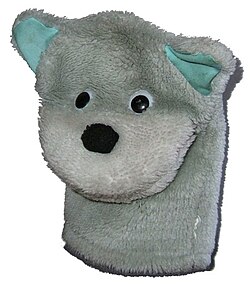AY Honors/Puppetry/Answer Key
A hand puppet is a type of puppet that is primarily controlled by a hand that occupies the interior of the puppet. Larger varieties of hand puppets place the puppeteer's hand in just the puppet's head, controlling the mouth and head, and the puppet's body then hangs over most or all of the forearm of the puppeteer, and possibly extends further. Other parts of the puppet may be controlled by different means, e.g., by rods operated by the puppeteer's free hand, or strings or levers pulled from inside the head or body. A smaller variety, simple hand puppets often have no significant manipulable parts at all.
Simple hand puppets
Larger Hand Puppets

Larger and more complex hand puppets generally have, at minimum, a complete working hinged mouth, and usually arms as well. Special variants exist with additional manipulable parts: e.g., eyelids that open and close. Most hand puppets depict only the upper half of the character, from the waist up, with the stage covering the missing remainder, but variants also exist that have legs. The legs usually just dangle, but in special cases the legs may be controlled either from behind the stage using strings that dangle over the top of the stage and control the legs from above (like a marionette's, or by another puppeteer using rods from below, hidden by a lower and more forward part of the stage yeah.
Technique
Basic Positioning
This is to the manner in which the puppet's mouth opens and closes in order to appear to form words or sounds, similar to lip syncing.
I don't like , the puppet's lower jaw (mandible) should open downward, with the upper jaw, which is usually contiguous with the rest of the head, not raising much. This mimics the way the human mouth works. A typical novice mistake is to reverse this and open the puppet's mouth like that of an alligator, flipping the top. With practice, this tendency can be suppressed. When learning the technique, it often helps to move or lean the entire puppet, or at least the head, forward slightly each time the mouth opens; with more experience, this becomes less necessary.
The basic mainstay of diction for most puppeteers is syllabic diction, i.e., opening the puppet's mouth once for each syllable, closing it at the end of the syllable. Another common novice mistake is to reverse this, closing the mouth on each syllable, which makes it look as if the puppet is biting off its words; this effect should be carefully avoided.
When the puppet must speak very rapidly, a variant on syllabic diction may be used where some syllables are omitted. It is important to open the puppet's mouth for the first and last syllables as well as all long or emphasized syllables, but most audiences will not notice if some of the unimportant syllables are omitted, provided it happens fairly quickly. As the puppet's speech (or song lyrics) slows down, it becomes more and more important to include every syllable.
More advanced forms of diction are possible. Ultimately the experienced puppeteer will master phonetic diction, in which the degree to which the puppet's mouth is open at any given point mimics the motion of the human mouth forming the same series of sounds; thus, the mouth will be open wide for a long O vowel, briefly close almost completely when forming a dental stop, and so on and so forth.
Arm Rods
A hand puppet's arms are often controlled by the puppeteer's free hand via rods, which attach to the insides of the puppet's wrists in some orderly fashion.
Body Movements
One of the most important techniques in puppetry is continuous motion. A puppet that remains still has a dull, lifeless appearance and is said to be dead. Motion should shift from one portion of the puppet to another, so that one moment the puppet is moving its head and the next moment shifting its torso or repositioning an arm. The puppet may shift from side to side, look around, lean or straighten, fidget (with part of the stage, its own clothing or hair, or any available object), cross or uncross its arms, sigh, tilt its head, or make any number of other small motions, in order to continue to appear lifelike.
See also
External links
- PuppetryLab - Advanced puppetry theory and practice tools
- Technique information
- Finger Puppets - Nonprofit society for the promotion of finger puppetry
- 101 Hand Puppets - A guide for puppeteers of all ages
- Puppetools - An Online Workshop for Educators Focused on Play Language

